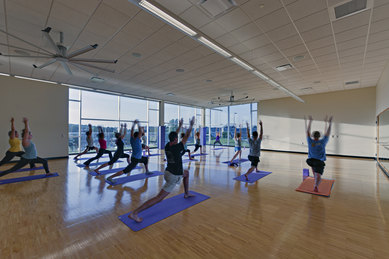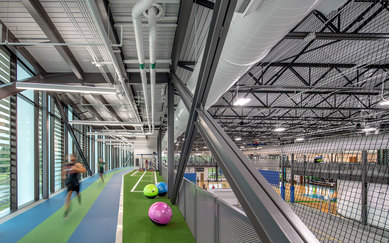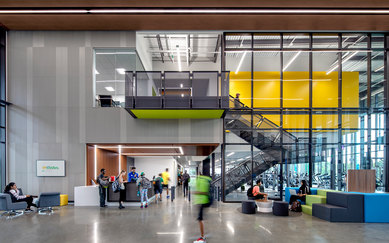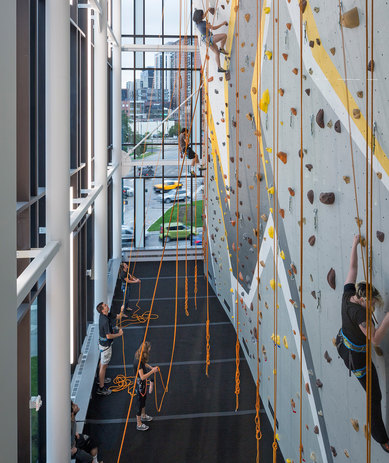From Recovery to Resiliency: Part 1 - Campus Recreation Responds to COVID-19
Every year, campus recreation leaders, health & wellness strategists and suppliers, and design professionals converge at the annual conference for NIRSA—Leaders in Collegiate Recreation. With sudden travel bans and campus closures due to the COVID-19 pandemic, NIRSA had to cancel this year's conference, leaving many wondering what comes next.
In response, SmithGroup organized a virtual dinner party on the day of the would-be conference, bringing recreation leaders and strategic consultants from across the country to share their perspectives on the challenges and opportunities the industry can expect in the near and distant future.
Our team was joined by Rick Hall of Texas A&M University, Dr. Wendy Windsor of Tulane University, Mike Warren of Purdue University, Amber Long of the University of Colorado Denver, Tim Mertz of HealthFitness, Eric Maki of Texas Tech University, Scott Vaculik of Sam Houston State University, and Tamara Jarrett of CORE Unlimited and Connect2Concepts.
Some key themes emerged during our conversation:
THE RAPID RESPONSE
Tech Savvy
Every campus demonstrated agility by hosting virtual content almost immediately. Purdue, for example, rolled out 11 virtual programs in the first week alone. While virtual programs have been successful, they have not been without challenges: security breaches during live streaming fitness classes (known as "zoombombing"), music copyright issues, closed captioning, tracking and assessing digital user data, and lacking adequate space or equipment to produce high-quality content.
Doing More With Less
Reducing budgets and putting some capital projects on hold is the reality for many universities. Some recreation departments do not receive student fee funding for online and distance learners, but are making a case with administration by showing the diverse virtual offerings students can access online outside of recreation alone—including on-staff registered dieticians, financial advisors and wellness counselors. Exploring new sources of revenue like these is important to providing quality programming to meet student demand and compete with private fitness clubs.
Community is the Competitive Edge
A few participants likened the COVID-19 experience to the aftermath of Hurricane Katrina, drawing parallels to students dealing with a sense of loss and isolation, despite the abundance of technology. As a result, there has been a strong emphasis on wellness programming like yoga, meditation and stress management to help students cope and stay motivated. Maintaining a sense of community and connection to the campus culture is important for students and is bolstered when they are able to interact with a favorite instructor online. To reinforce these connections, virtual experiences should be branded for each campus community.
We can’t really compete with some of the big box programs like Les Mills and Peloton in terms of quality, but what we can do is center our content on the people our students know. If we can make our content about Boilermakers and give them a class with their favorite instructor, therein lies our success.
Mike Warren
Director of Recreation and Wellness, Purdue University

THE RETURN TO CAMPUS
Safety and Resiliency
The focus of summer and fall 2020 will be safely reintegrating students into campus recreation once back on campus. With social distancing requirements and hybrid learning taking place, recreation departments are tackling concerns like cleaning and disinfecting, spacing equipment, reducing class sizes, controlling access, and reconfiguring or repurposing large, informal spaces like basketball courts, climbing walls, and locker rooms that are traditionally high-contact zones. More drastic potential changes include adapting recreation spaces into overflow academic space to support other departments on campus or significantly reducing the maximum occupancy of recreation facilities. Adaptability and resiliency is key when transitioning facilities and students back to on-campus programs over the next year.
Connecting with the "Elusive 15"
Though many campuses have not yet set dates for reopening campus recreation, there is an overarching expectation that hybrid learning will become the new normal. Virtual programming will become a significant arm of campus recreation indefinitely. Leveraging virtual programming, especially as the quality continues to improve, is a strategy to capture a different demographic of student who may not have engaged with campus recreation before. Historically, this has been roughly 15 percent of the student population, referred to by one participant as the "Elusive 15." Through partnerships with programs like eSports or simply by creating more sophisticated, navigable digital platforms, there is potential to reach more students through shared virtual experiences.
The amount of virtual programming content is vast, but the challenge for campus rec is creating our own branded content so students don’t lose that sense of allegiance to their institution. Allowing students to connect with their favorite instructors through the screen is a differentiator for us, but we also need to determine the right delivery method that allows us to track and assess the data, and prove its value.
Tamara Jarrett
President & Co-Founder, Core Unlimited and Connect2Concepts
THE LONG ROAD AHEAD
Think Like A Business
With anticipated drops in enrollment and dips into financial reserves imminent, campus recreation leaders are realizing the need to hone their business acumen when it comes to operational structures. Identifying new revenue generating sources, exploring third-party partnerships with fitness boutiques like F45 and Orange Theory, monetizing virtual classes through memberships with alumni and the local community, and pursuing private donors for endowments are just a few of the initiatives discussed to combat the effects of COVID-19 and stay profitable into the future.
We will be able to control some of our smaller areas like group exercise classes, so I feel confident they can continue on in a similar capacity. My concern is greater for the informal spaces like basketball courts, locker rooms and climbing walls—that will be the gray area for us.
Eric Maki
Managing Director for Recreational Sports, Texas Tech University
During my time at MIT, "maker space" labs were all over campus and encouraged students to come in and use things like 3D printers, laser cutters or woodworking tools. I can imagine having spaces like this for campus rec, programmed with technology needed—lighting, audio, video capture, green screens—to easily walk in and create content.
Tim Mertz
Senior Director for College & Community Recreation, HealthFitness
A New Kind of "Maker Space"
Being able to dynamically transform from in-person to digital delivery of programs will be essential spatially and operationally. Similar to the concept of the maker space, we discussed the idea of a production studio prototype where students and staff could drop-in and easily produce content with the right infrastructure in place—and could even be rented out to other departments on campus or the community for revenue generation.
As we plan for the future, recreation space will need to be adaptable to change and more resilient, enabling campus recreation to endure and quickly recover from acute shocks and economic or environmental stressors.
Stay tuned for the next post of this series entitled, "Integrating Fitness and Wellness on Campus."


